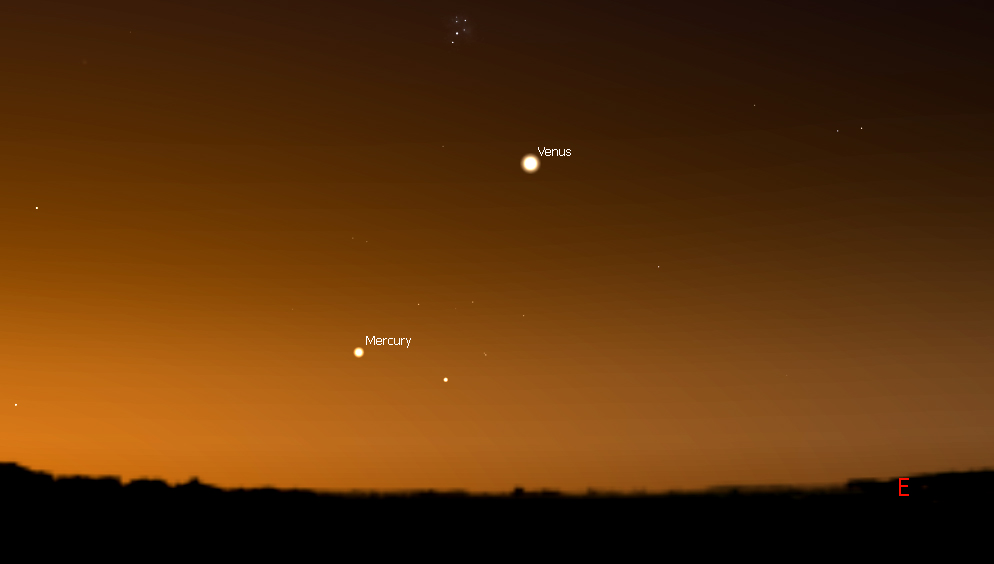Center your sights on Venus, then look down and to the left about 10 degrees, roughly the width of your fist. There, you may glimpse a fiery spark in the growing twilight: Mercury. If you are successful, enjoy the moment, for it is a rare sighting!
 Mercury is a difficult planet to spot under the best of conditions, but in late June 2022, especially around June 24, Venus is well-positioned to aid in finding the elusive innermost planet. Bright Venus is easy to see, and on this morning, Mercury is found down and to the left at a distance about the width of your fist held against the sky. (Made by Ben Burress using Stellarium)
Mercury is a difficult planet to spot under the best of conditions, but in late June 2022, especially around June 24, Venus is well-positioned to aid in finding the elusive innermost planet. Bright Venus is easy to see, and on this morning, Mercury is found down and to the left at a distance about the width of your fist held against the sky. (Made by Ben Burress using Stellarium)
On June 24, the waning moon will move farther east and diminish to a delicate crescent, staging a finale for this rare and beautiful assembly of celestial orbs.
In the days after, the moon will dive into the dawn, and Mercury will disappear quickly into the sun’s glow, followed in August by Venus. Mars, Jupiter and Saturn will remain prominent well into autumn, but spread farther and farther apart over the weeks, dissolving their close partnership of summer.
How rare is this alignment?
All five visible planets gathering in the same patch of sky occurs, on average, every 20 years.
Matchups of two planets happen regularly. As the planets circle the sun at their various orbital velocities, they pass each other like cars on a freeway moving at different speeds. Mars makes a complete circuit around the ecliptic — the great circle that the sun and planets travel along as seen from Earth — about every two years, reliably buzzing Jupiter and Saturn each time.
The inner planets Mercury and Venus — closer to the sun than Earth — move more quickly, emerging from the sun’s glare in the morning and evening in seasonal turns, cyclically lining up with more distant planets as they go.
 The orbital positions of the planets out to Saturn in the second half of June 2022. As viewed from Earth, the five planets possible to see with the naked eye fall in a westward sweeping line from the sun, all appearing together in a dazzling lineup before fading in dawn’s light. (NASA/JPL/Orbit Viewer)
The orbital positions of the planets out to Saturn in the second half of June 2022. As viewed from Earth, the five planets possible to see with the naked eye fall in a westward sweeping line from the sun, all appearing together in a dazzling lineup before fading in dawn’s light. (NASA/JPL/Orbit Viewer)
Sometimes these pairings are breathtakingly close, bringing a pair of planets within a thumb’s width of each other, or closer. Venus and Jupiter had such a rendezvous in late April, passing less than half a degree from each other as seen from Earth.
But the chance to see all five of the visible planets in one vista is rare. The celestial math of the planets’ dance only brings them together every couple of decades, and when the sun gets into the act we may not see the performance at all. The last time these planets clustered together, in May of 2000, the sun was right in the middle of the stage and outshined all the other luminaries.
So June brings a rare opportunity to gaze upon all the visible planets, compare their brightness and color, and appreciate the celestial choreography that allows us to witness such splendor. You need to get up early to enjoy the show, but it’s worth it!


















